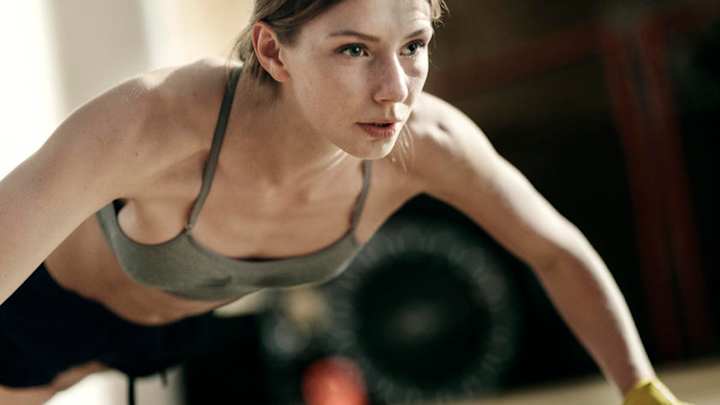Researchers have found yet another benefit of HIIT workouts

HIIT—or high intensity interval training—has been the buzzy sweat method for a while now. These fast-paced workouts alternate short bursts of exercise with quick recovery periods, and torch more calories in less time than traditional steady-state training sessions. HIIT has been shown to boost metabolism, melt fat, build muscle, and more—and now, Mayo Clinic researchers have discovered yet another benefit: it can reverse signs of aging at the cellular level.
The study, published in the journal Cell Metabolism, involved 72 sedentary adults in two age groups—young (18 to 30) and older (65 to 80). The participants were assigned to one of three 12-week workout routines: high-intensity interval cycling, strength training with weights, or a combined strength-training and cycling plan.
7 reasons you're not building muscle even though you're lifting weights
The HIIT cycling plan was the most rigorous of the three. It required three days of cycling (four, 4-minute high-intensity intervals broken up by 3-minute recovery periods), and two days of steady, brisk treadmill walking. The strength-training group performed upper- and lower-body exercises just twice a week, while the combined-training group worked out five days a week but without intervals, and for less time.
Researchers measured changes in the volunteers’ leg strength, lean muscle mass, oxygen capacity, and insulin sensitivity. They also biopsied tissue samples and analyzed cells from the volunteers' thighs before and after the three-month experiment. At the end of the 12 weeks, all three exercise groups had gained lean muscle and improved aerobic capacity, but those who did high-intensity interval training (HIIT) got the biggest benefit at the cellular level. Younger volunteers experienced a 49% boost in mitochondrial capacity—the cell’s ability to take in oxygen and produce energy—while older folks experienced an even more dramatic 69% increase.
Mitochondria and ribosomes are organelles that are important for metabolism and aerobic fitness, but tend to deteriorate as people get older. Keeping these structures healthy can reverse some signs of age-related decline within cells, say the researchers.
• The Best HIIT Workout for Toned Abs
“The greater a person’s mitochondrial capacity, the greater capacity they have to breathe in, transport, and utilize oxygen to perform physical exercise and maintain healthy cell function,” explains Paul Arciero, PhD, professor of health and exercise sciences at Skidmore College. “In essence, the health of a cell—and our body—is directly dependent on the functioning of the mitochondria.” Arciero was not involved in the new study, but says the results are "very meaningful and somewhat surprising."
Neither age group in the strength-training program experienced significant mitochondrial increases. And in the combined training group, only the younger group saw improvements.
The HIIT cycling group also saw improvements in insulin sensitivity, suggesting that this type of exercise may reduce diabetes risk. It also increased the activity of ribosomes, the part of the cell that builds proteins needed to create muscle cells. That’s important because muscle cells aren’t easily replaced when they wear out—one reason why people lose muscle mass as they get older, explains Sreekumaran Nair, MD, a diabetes researcher at the Mayo Clinic.
Still, HIIT did not build as much strength or lean muscle mass over the 12-week period as strength-training did. Dr. Nair says the study wasn’t designed to make specific recommendations, but he does suspect that three to four days a week of HIIT plus a couple days of strength training may be the best way to slow the down aging process.
First Look: Under Armour's collection at Kohl's
Co-author Matthew Robinson, PhD, a former Mayo Clinic researcher and now an assistant professor of kinesiology at Oregon State University, says that adding short bursts of higher intensities is a great way to gain more benefits from exercise. “It could be trying to find a walking path that includes hills or pedaling faster for a short period for people who like to bike,” he told Health in an email, cautioning that people who are new to intervals should progress gradually over several weeks.
While all types of exercise are good for us, Arciero says, HIIT seems to have additional cellular benefits that may, over time, have implications for maintaining muscle, aerobic fitness, and insulin sensitivity as we age. “In other words, HIIT mobilizes a powerful army of genes deep within our cells that we don’t realize are helping us in the immediate present time,” he says, “but likely have a delayed or latent effect that will affect the body in very beneficial ways.”
Robinson agrees that “some activity is better than none to promote health during aging,” and says that adding intervals can help the body adapt to new physical demands. “Raising intensity may help people reach their next goals,” he adds, “whether it is improving fitness or simply being more active.”
This article was originally published on Health.com.
